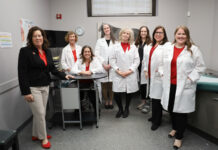A Christian doctor who is proselytizing to her patients. A Moslem medical student who wants to pray five times a day.
University of Louisville second-year medical students discussed these case studies in a Jan. 11 session of the four-week-long, required course, At the Intersection of Medicine and Spirituality.
Other medical schools offer humanities courses to students as electives, but UofL requires that students take two humanities courses as part of their medical school education. That sets the school apart in a way school leadership feels is important.
Robert Maynard Hutchins, the president of the University of Chicago in the 1930s, said that we are all liberal artists; to live life is to be a liberal artist, quoted Edward C. Halperin, dean of the School of Medicine.
Since we are all, therefore, liberal artists, the only question is whether we shall be good ones or bad ones. I think it is essential that physicians be good ones, he said.
In addition to At the Intersection of Medicine and Spirituality, taken in the second year of study, the humanities element of the Uof L medical curriculum also requires first-year students to take History of Medicine. Students may elect to take another humanities course during their last year of study.
Class format allows for interaction with experts. The Jan. 11 session included panel members Jesse Roman, UofL’s new chair of the Department of Medicine; Avrohom Litvin, an Orthodox Jewish rabbi; Sikh psychiatrist Amarjit Chopra; Roman Catholic priest Tony Smith; and the Rev. Ronald Oliver, a protestant minister who also is a chaplain at Norton Hospital.
Roman told students that it is important to be able to deal with the issues that can arise from people’s differing faiths and cultural backgrounds: Not facing these issues can negatively impact patient care, and education, he said.
Litvin explained that from his perspective, on many levels religion is a need and not a want.
You’ve got to figure out what’s the need and what’s the want, and provide for the needs, not the wants, he said.
Panelist interaction and comments spoke to the complexity of the issues, as the conversation also reached such topics as whether students should share their religious preferences with residency interviewers and the question of authority and power that religion in the setting of medical care can raise.
Disputes between junior and senior physicians, students and teachers, or patients and doctors about religious issues are sometimes about the substance of the dispute and sometimes about who is in a position of power and who is not, Halperin said.
Class discussion of the topics at hand and required reading also takes place in small groups, which faculty members, including representatives of the local Baptist and Presbyterian seminaries, lead.
In subsequent weeks, students in the class will consider ethical questions related to marriage and dementia and how to respond with patient requests that the doctor pray with them.
The humanities element of medical education is imperative, according to students. In fact, said first-year student Alex Bajorek, it is imperative.
A patient is a living collection of familial traditions, cultural values and biases, said Bajorek, who also is finishing a master’s degree in bioethics and medical humanities. Without a solid grasp of the humanities, much like what is offered in liberal arts colleges, a medical student can only come out half-prepared to practice the ‘art’ of medicine.
According to Halperin, the humanities courses complement one another as part of the medical school curriculum.
A competent physician must have an understanding of the history of his or her discipline, which is, in part, acquired by a course in the history of medicine, he said. Medical history teaches humility, courage and the interface of medicine and society. A course in the intersection of religion and medicine teaches students sensitive and compassionate techniques of interacting with patients and society when medicine and faith traditions intersect.
Halperin received a Kentuckiana Metroversity Instructional Design Award for the spirituality and medicine course in 2009. The award recognizes innovative ways that faculty help students to learn.
At the Intersection of Spirituality and Medicine is open to physicians seeking continuing medical education credit, as well as to the interested public. Class feedback, which first was offered last year, has been positive. One student wrote in an evaluation: The topic is highly relevant to the practice of medicine and also raised important issues about patient management, cultural and religious sensitivity and ethico-legal implications.




























